![]()
![]()
![]()
Use LEFT and RIGHT arrow keys to navigate between flashcards;
Use UP and DOWN arrow keys to flip the card;
H to show hint;
A reads text to speech;
37 Cards in this Set
- Front
- Back

1. What is the major organic product obtained from the following reaction? a. only 1 b. only 2 c. only 3 d. only 1 and 2 |
A |
|
|
2. Which of the following amino acids is not chiral? a. leucine b. proline c. glycine d. alanine |
C |
|
|
3. Which of the following is not true? a. grease molecules absorb on to the surface of micelles b. sodium soaps are prepared by saponification of triglycerides c. a by-product of the saponification of triglycerides is glycerol d. soap molecules assemble into micelles |
A |
|
|
4. Which of the following is a definition of the isoelectric point of an amino acid? a. The melting point of an amino acid b. The pH at which the α-NH2 group is completely protonated c. The conductivity of a 1 M solution of an amino acid in water d. The pH at which an amino acid has no net charge |
D |
|
|
5. What is the biological precursor of prostaglandins? a. linolenic acid b. arachadonic acid c. oleic acid d. stearic acid |
B |
|
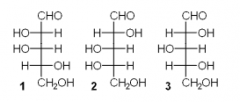
6. Which of the following has a D-configuration? a. only 1 and 2 b. only 1 and 3 c. only 2 and 3 d. only 1, 2 and 3 |
B |
|

7. What is the major organic product obtained from the following reaction? a. 1 b. 2 c. 3 d. 4 |
B |
|
|
8. What is the isoelectric point of serine (pKa of α-CO2H, 2.21; pKa of α-NH2, 9.15)? a. 11.36 b. 20.22 c. 5.68 d. 9.94 |
C |
|

9. Which carbon in the following carbohydrate is the anomeric carbon? a. i b. ii c. iii d. iv |
A |
|
|
10. What is the approximate value of the pKa of the α-CO2H of amino acids? a. 2 b. 12 c. 9 d. 5 |
A |
|
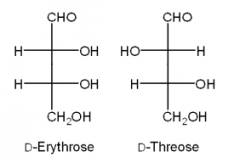
11. What is the relationship between D-erythrose and D-threose? a. they are constitutional isomers b. they are diastereomers c. they are tautomers d. they are enantiomers |
B |
|

12. Which of the following structures represent the same carbohydrate? a. only 1 and 2 b. only 1 and 3 c. only 2 and 3 d. 1, 2 and 3 |
C |
|
|
13. To what structural feature does the term "primary structure" refer? a. the conformation of local regions of polypeptides b. the overall folding pattern of proteins c. the sequence of amino acids in proteins d. the aggregation of polypeptides |
C |
|
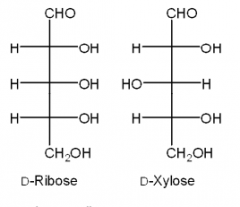
14. What is the relationship between D-ribose and D-xylose? a. they are diastereomers b. they are constitutional isomers c. they are tautomers d. they are enantiomers |
A |
|
|
15. To what structural feature does the term "secondary structure" refer? a. the overall folding pattern of proteins b. the sequence of amino acids in proteins c. the conformation of local regions of polypeptides d. the aggregation of polypeptides |
C |
|
|
16. To what structural feature does the term "tertiary structure" refer? a. the sequence of amino acids in proteins b. the conformation of local regions of polypeptides c. the aggregation of polypeptides d. the overall folding pattern of proteins |
D |
|
|
17. To what structural feature does the term "quaternary structure" refer? a. the overall folding pattern of proteins b. the conformation of local regions of polypeptides c. the aggregation of polypeptides d. the sequence of amino acids in proteins |
C |
|
|
18. Which of the following is not an intermediate in the biosynthesis of cholesterol? a. acetyl coenzyme A b. isopentenyl pyrophosphate c. squalene d. arachidonic acid |
D |
|
|
19. What is the approximate value of the pKa of the α-NH3 a. 2 b. 5 c. 9 d. 12 |
C |
|
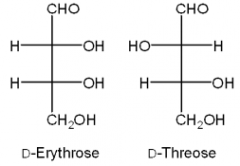
20. What is the relationship between D-erythrose and D-threose? a. they are constitutional isomers b. they are enantiomers c. they are diastereomers d. they are tautomers |
C |
|
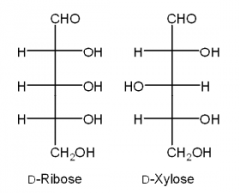
21. What is the relationship between D-ribose and D-xylose? a. they are constitutional isomers b. they are enantiomers c. they are diastereomers d. they are tautomers |
C |
|

22. Which carbon in the following carbohydrate is the anomeric carbon? a. i b. ii c. iii d. iv |
A |
|
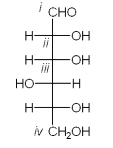
23. Which carbon in the following carbohydrate is the anomeric carbon? a. i b. ii c. iii d. iv |
A |
|
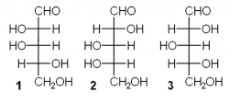
24. Which of the following has a D-configuration? a. only 1 and 2 b. only 1 and 3 c. only 2 and 3 d. only 1, 2 and 3 |
B |
|
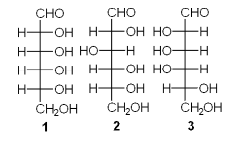
25. Which of the following has a D-configuration? a. only 1 and 2 b. only 1 and 3 c. only 2 and 3 d. only 1, 2 and 3 |
D |
|

26. What is (are) the major organic product(s) obtained from the following reaction? a. only 1 b. only 2 c. only 2 and 3 d. 1, 2 and 3 |
C |
|

27. What is the major organic product obtained from the following reaction? a. 1 b. 2 c. 3 d. 4 |
B |
|

28. Which of the following represents a furanose? a. only 1 b. only 2 c. only 3 d. only 2 and 3 |
B |
|
|
29. Which of the following is not a polysaccharide? a. amylose b. amylopectin c. glycogen d. ribulose |
D |
|
|
30. Which of the following processes is used to harden an oil to give a fat? a. oxidation b. hydrogenation c. hydrolysis d. hydration |
B |
|
|
31. What is the biological precursor of prostaglandins? a. stearic acid b. arachadonic acid c. oleic acid d. linolenic acid |
B |
|
|
32. Which of the following amino acids is not chiral? a. leucine b. glycine c. alanine d. proline |
B |
|
|
33. Which of the following amino acids is a secondary amine? a. proline b. glutamine c. cysteine d. aspargine |
A |
|
|
34. Which of the following amino acids has an aromatic side chain? a. tyrosine b. glutamine c. aspargine d. valine |
A |
|
|
35. Which of the following amino acids has a sulfhydryl group? a. serine b. cysteine c. lysine d. tyrosine |
B |
|
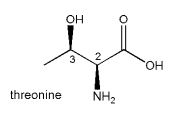
36. What are the R/S designations of the two stereocenters of L-threonine? a. 2R,3R b. 2R,3S c. 2S,3R d. 2S,3S |
C |
|
|
37. What is the isoelectric point of serine (pKa of α-CO2H, 2.21; pKa of α-NH2, 9.15)? a. 5.68 b. 9.94 c. 11.36 d. 20.22 |
A |

